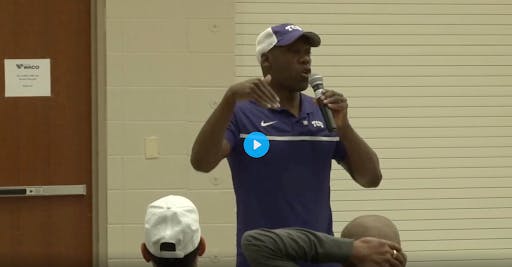Featured courses
- The Ultimate Guide to Coaching Track and Field by Jackson Chlebowy
- How TCU Coach Khadevis Robinson Builds Mental Toughness for Big 12 Track by William Markey
- Two Points of Focus When Coaching and Training Hurdles by Grant Young
- Four Keys to Maximize Winning Potential in a 400m Race by Grant Young
- Three Lessons Every Distance Running Coach Should Know by Grant Young
- Olympic Medalist Jasmine Moore’s Triple Jump Approach Technique Keys by Grant Young
- Build Strong Triple Jump Foundations with 3 Key Drills by William Markey
- Two Cues to Help With Track and Field Relay Handoffs by Grant Young
- Four Shot Put Drills to Help Develop Your Athletes by Grant Young
- Three Training Tips For Coaching 400m Runners by Grant Young
- Four Tips for Teaching the Javelin Throw by Grant Young
- 3 Pole Vault Check Points From Legendary Kansas Coach Tom Hays by Grant Young
- Two Valuable Hammer Throw Training Tips by Grant Young
- 3 Must-Try Offseason Shot Put Drills by William Markey
- Four Essential Tips For Coaching Track Relays and Sprints by Grant Young
- Florida Gators Coach Nic Petersen’s Two Keys for Teaching the Triple Jump by Grant Young
- Three Effective Drills for Improving the Long Jump by Grant Young
- Three Drills for Sprinters That Track Coaches Swear By by Grant Young
- Four Pole Vault Drills All Track and Field Coaches Should Know by Grant Young
- Explosive Track and Field Training to Level Up This Summer by Tyler Rathke
- Throwing Secrets: The Entry by Tyler Rathke
- How to Find an Endurance Athlete’s Proper Training Pace by Grant Young
- The Technique Behind Mykolas Alekna’s Discus World Record by Grant Young
- How to Build a Sprinter's Training Regimen by Grant Young
- How to Teach the Glide Shot Put by Grant Young
- Three Hurdle Drills All Track Coaches Should Know by Grant Young
- How Distance Running Coaches Can Get the Most Out of Their Athletes by Grant Young
- The Technique Behind Mondo Duplantis' Pole Vault World Record by Grant Young
- How to Coach Weightlifting For Increased Speed and Acceleration by Grant Young

How TCU Coach Khadevis Robinson Builds Mental Toughness for Big 12 Track
Khadevis Robinson is a two-time Olympian and TCU Hall of Famer, currently serving as TCU’s Director of Track and Field, as well as primary coach for middle distance events.
As the team prepares for the upcoming Big 12 Outdoor Track & Field Championships in Kansas, Robinson’s approach goes far beyond workouts and splits.
What he's building isn’t just physical readiness — it’s mental resilience. It’s a belief developed through tailored training, where athletes learn not to chase someone else’s mileage, but to master their thresholds.
At this level, it’s not about doing more — it’s about doing what works. His athletes have already lived the discomfort. They’ve pushed through the doubt. And now, when the lights are bright and the stakes are high, they’ll know exactly what to do — because they’ve already done it.
Train the Mind, Not the Body

He doesn't just condition the body — he conditions belief. Khedevis trains athletes to break through their perceived physical limits.
And he does it by engineering chaos in a controlled practice environment. Why? Because racing is never neat. It's not rehearsed. It's unpredictable.
He deliberately compresses rest. He films the workouts. He alters pacing instructions without telling the athlete, not to deceive, but to disrupt their limiting beliefs. Because when a 2:15 girl unknowingly runs a 2:11, she’s no longer the same athlete. Her ceiling has been raised. Her future just changed.
Chaos becomes the coach. Pressure becomes the plan. And belief becomes the fuel.
High Performance Isn’t One Size Fits All

What starts as a conversation about middle-distance training quickly becomes a profound lesson in individualized performance.
Robinson shares how, instead of following standard mileage numbers, he listened to his athletes, diagnosed the real issue, and made one key adjustment: Don’t push past 50 miles if that’s the injury threshold.
It wasn’t about doing more—it was about doing what works for that person.
Robinson reminds us that copying someone else’s “high-performance formula” without knowing your limits is a recipe for burnout, not guaranteed success.
When you take both of these insights—training beneath injury thresholds with precision, and simulating chaos to build race-day confidence—you get a powerful preparation model for the Big 12 Championship.
No surprises on race day—because they’ve already lived the chaos, felt the pain, and proven to themselves that they can run through it.
For the Big 12 stage, where the environment is loud, the stakes are high, and the competition is fierce, Robinson’s athletes won’t just be ready physically—they’ll be mentally armed to deliver their best when it counts most.
Thank you, Coach, and the TTFCA for sharing these clips from the clinic Race Strategy.




